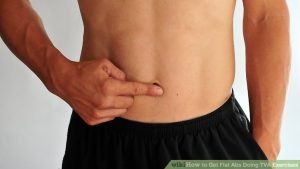Wouldn’t it be nice?
Getting a flat stomach is, let’s face it, a ‘nice-to-have’ goal.
We know it won’t change us at a fundamental level, but it sure might make us feel just a little bit better about ourselves. And if ‘flat’ isn’t achievable, then flatter would sure be nice.
And whenever this niggly little idea pops back in our head, we go for what we instinctively think might work. Jogging on the treadmill or doing endless crunches. But sadly, this is not an effective route to our destination.
We take a look at a few simple tips that help in the pursuit of a flat stomach.

Getting a flat stomach
Getting a flat stomach – Focus on nutrition first
One of the reasons that your belly may be looking more pronounced than it should is because of inflammation. There are certain foods that can cause inflammation that should be minimised or cut out. Keeping a closer eye on reducing inflammatory food and increasing anti-inflammatory foods will have a fairly quick impact.
One of the biggest culprits in causing inflammation is white flour or wheat. While wheat is the most commonly used grain worldwide, other grains such as corn and rice are now also being processed into white flours too.
Processed white flours and grains usually contain little to no nutrients. The effects of eating white flour products include bloating, water retention, sugar crashes and digestive issues like constipation & diarrhea.
Cutting out white flour is probably the biggest single contributor to getting a flatter stomach. It is better to stick to 100% whole grain products and wholegrain stoneground flours – these are a lot more nutritious and more filling.
Other foods to cut back on include dairy, fruit juices, rich salad dressings, dried fruit and snack bars or energy bars. You are better off introducing more fresh veggies, fresh fruits and small quantities of raw almonds to stave off some of the hunger pangs.
How exercise can help
Many people look for the perfect upper body exercise to flatten the stomach. But a recent study (2016), in the Journal of Sports Medicine and Physical Fitness found that HIIT training was highly effective in helping to reduce visceral fat. HIIT stands for High-Intensity Interval training.
Consider trying Pilates
The abdominal muscles, lower back, and buttocks are at the center of all movement in Pilates. This allows the rest of the body to move freely.
Unlike conventional crunches or sit-ups which work the more external muscles, Pilates tends to work the deeper abdominal muscles that give the stomach a flatter appearance. It also has many benefits for posture which will also give the stomach a flatter appearance.
Remember though, that you shouldn’t expect results overnight. That being said, the pursuit of a flatter stomach is not beyond you.
We hope this information is useful for you. If you have any questions about our treatments, please contact us. You can find us in Mill Hill Broadway and Islington. If you like this blog, please share!
We are always happy to help!



